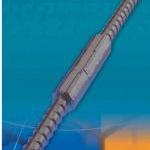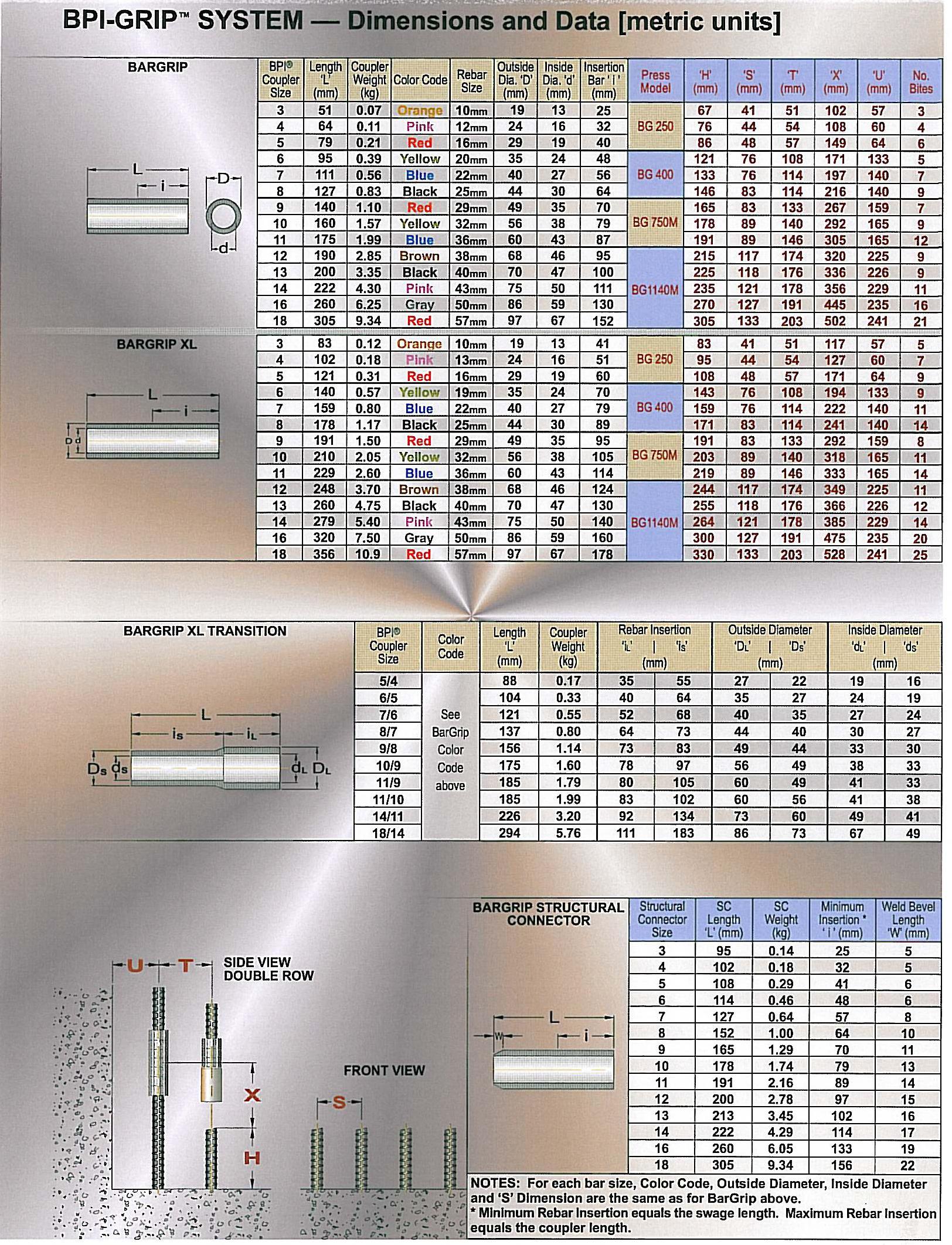BPI BAR GRIP
Mechanical Bar Grip type splice bar sleeves that allow a complete traction-compression transmission of efforts using BP 2600 equipment (workshop) or BG400 or BG750M equipment according to diameters (in situ) making several bites at the sleeve.
Dimensions and product references
Applications
FIELD SPLICE OPTIONS FOR YOUR PROJECTS
BARGRIP - STANDARD TYPE 1 SERIES
COLD SWAGED STEEL COUPLING SLEEVE

• FOR STANDARD REINFORCING BARS- ASTM A 706, ASTM A 615, ASTM A 996 and equal black deformed bars - exceeds 125% x specified yield, fy, Grades 40, 50 and 60.
• ACI 318 CHAPTER 12 FULL MECHANICAL SPLICE - BarGrip develops in tension or compression, as required, at least 1.25 fy of the bar.
• SUPERIOR TO ALL TENSION LAP SPLICES - BarGrip strength is independent of surrounding concrete and cover. Takes up less space. Replaces lap splice classes A, B, or C.
• TYPE 1 SPLICE - ACI 318 Chapter 21 and International Building Code. ICC ES Legacy Report ER-3848. Complies with AASHTO "Standard Specifications for Highway Bridges."
• COMMERCIAL APPLICATIONS - In accordance with Building Code Requirements for Structural Concrete, BarGrip is used in columns, beams, walls, mats, tanks, parking garages.
• DOT PROJECTS - Bridges, piers, caissons, deck steel and highway ramps - Exceeds 125% x fy and 135% x fy uncoated ASTM A 706 or A 615 Grades 40 - 60.
BARGRIP XL - NUCLEAR/TYPE 2 SERIES
COD-SWAGED STEEL COUPLING SLEEVE

• NUCLEAR SAFETY RELATED - ASME Section III, Division 2 - Swaged splices with a tensile strength = 90,000 psi (150% x specified yield) used with ASTM A 615 Grade 60.
• TYPE 2 SPLICE - ACI 318 Chapter 21 Seismic Design and International Building Code. BarGrip XL develops specified tensile strength of black deformed bars ASTM A 706 or A 615.
• CALTRANS SERVICE and CALTRANS ULTIMATE - BarGrip XL meets slip test 670 and capable of developing the actual ultimate strength of black deformed bars ASTM A 706.
• SEISMIC LOADING - BarGrip XL withstands plastic strain excursions to 5 x rebar yield strain value and stress reversals in accordance with ICC Acceptable Criteria AC-133, ICC Report No. ESR-2299.
• DYNAMIC LOADING - Structures designed to resist the effects of accidental explosions; capable of developing the dynamic yield stress of Grade 60 reinforcing in 10-15 milliseconds.
• HIGH STRENGTH BARS and COATED BARS - 133% fy black ASTM A 615 Grade 75. 125% fy Grade 80. 135% fy Grade 60 epoxy coated ASTM A 775 or galvanized ASTM A 767.
BARGRIP UXL - EPOXY BAR/TYPE 2 SERIES
COLD-SWAGED STEEL COUPLING SLEEVE

• UTAH DOT SPECIAL PROVISIONS - Capable of developing in tension 175 percent of specified yield strength of deformed epoxy coated bars conforming to ASTM A775 Grade 60.
• PERFORMANCE and ASSURACE - Meets or exceeds the performance attributes of BarGrip XL. Inherently provides added level of assurance under more sever conditions.
• SPECIALTY SPLICE and SPECIALTY APPLICATIONS - Used to mechanical splice bars that have substantial spaces between the bar ends - up to 2-inch gaps often possible.
• OLD REINFORCEMENT - the additional insertion captures more deformations and provides greater interlock with rebars that do not conform to current ASTM specifications.
• ADVERSE CONDITIONS - Higher tolerance to field contamination, concrete spatter, corroded rebars or undersize and missing deformations.
• PROBLEM SOLVER - Highly ductile steel, adaptable splicing system for special details, weldable to structural steel and similar.
BARGRIP STRUCTURAL CONNECTOR
COLD SWAGED STEEL COUPLING SLEEVE

• FULL STRENGTH - ASME Section III, Division 2 = minimum joint strength 75,000 psi with average tensile strength 90,000 psi (150% x specified yield) used with ASTM A 615 Grade 60.*
• COMPATIBILITY - Cold swage to black ASTM A 615 or epoxy coated ASTM A775 Grade 60 or galvanized ASTM A 767 Grade 60. Capacity to exceed 1.25 fy in all cases.
• VERSITILITY - For attachment of reinforcing bars to liner plates, structural steel shapes or for creating headed anchorage. Shop or field weldable, before or after bar placement.
• CERTIFIED LOW CARBON STEEL - Conforms to CC-2310 (c ) material requirements of ASME Section III, Division 2. Meets chemistry AISI Grade 1018 and ASTM A 36.
• WELDING BEVELS - For full penetration, provided for greater strength, convenience and quality assurance. Suited to E7018 electrode.
• LESS WELD STRESS - Compared direct butt welds because outside diameter of structural connector is larger than the reinforcing bar so the weld area is disposed over greater length.
•
*Welder qualification, weld procedure, integrity and strength are the responsibility of others.
Features
Bar sizes No.3 through 18 (dia.10-57mm) can be spliced by this method including bars of different sizes. BPI-Grip coupling sleeves are available for use with reinforcing bars that comply to ASTM A 615, ASTM A 706, ASTM A 996, or equal.
Epoxy-coated steel reinforcing bars that comply to ASTM A 775 can be spliced by suitable cold-swaged steel coupling sleeves with shielding or removing the epoxy coating from the bar.
Hot-dipped galvanized cold-swaged steel coupling sleeves can be ordered for mechanically splicing zinc-coated (galvanized) steel bars that comply to ASTM A 767.
The cold-swaged splicing method is suitable for new construcions, field repair applicatons, and the splicing of older types of reinforcing bars, provided such bars have suitable deformations for mechanical interlock.
No special bar end preparation is required so ends can be sheared, sawed, or flame cut; however, a bar-end check is recommended. Bars can be connected from any orientation because special positioning of the press around the bar is not required. In the structure, linear alignment is preserved across the splice by using reinforcing bars with straight ends and securing the loose continuation bar in the desired position at the time of swaging.
Benefits
Cold swaging technology for mechanical splicing of reinforcing bars is one of the most established, developed, and refined splicing methods worldwide. Key to cold swaging success is it simplicity, low cost, and adaptability. There is no loss of reinforcing bar cross-sectional area at the splice location so the BPI-Grip system is a natural choice when considering the objectives of seismic design, blast resistance and safety related nuclear applications.
• Lap splices are not recommended in locations where inelastic yielding could occur because such splices are not reliable under conditions of cyclic loading into the inelastic range.
POSITIVE mechanical interlock
Powerful range of hydraulic presses
SPLICES for all bar sizes US and international
CHOICES for Type 1 Type 2 or higher
BLACK or GALVANIZES or Epoxy Coated Bars
NEW CONSTRUCTION Repair or retrofit
FIELD or SHOP-FIELD Installation
SHEARED or flame or saw cut bars
TRUE CONTINUITY and load path where you need it
Function
BPI-Grip cold-swaged coupling sleeves consist of seamless Steel sleeves that slip over the ends of reinforcing bars.
They are deformed onto the reinforcing bar profile to produce mechanical interlock.
Mechanical interlock with reinforcing bar deformations, lugs or protrusions is the basis of swaged splice strength. The "slip test" values of swaged mechanical splices are minimal due to the tight conformation of coupling sleeves to the profile of the bar. Best of al, rue structural continuity can be established in reinforcing systems because swaged splice strengths, unlike lap splices, are not dependent upon the compressive strength or cover requirements of the surrounding concrete.
• In comparison to manual arc welding, cold swaged splices are faster to install, require a lower skill level, do not require a chemistry determination of the reinforcing bar being splices, do not require bar pre-heat or post-heat and do not require radiographic examinations.
Works carried out
- Torre Iberdrola. Bilbao
Photo gallery
Installation
The reinforcing bar is marked and inserted halfway into the sleeve. A hydraulic press fitted with a removable two-piece die set is used for field installation. The die set deforms the first half of the coupling sleeve in a radial direction onto the reinforcing bar in a series of overlapping pressings. The coupling sleeve is slipped over the bar in-situ and the remaining unswaged portion of the sleeve is swaged. Field-type presses, including dies, weigh between 20 and 230 lb (9 and 105 kg) and can be supported for use in any orientation.
Bench presses with adjustable stops and insertion gauges are available for shop use. These machines efficiently half-swage a coupling sleeve onto the end of a reinforcing bar before shipping. Adapter kits allow the field presses to be used in the same way.

BPI-Grip swaging equipment is easy to use and may be leased or purchase. Splicing manuals provided with equipment explain step-by-step installation and safety information.

Installation images
Quality Control

- Instituto Americano del Hormigón, código de la Edificación AC1318
-Código de Seguridad nuclear estructural AC1349
-ASME SECCION III, División 2
-Corporación de Ingenieros de USA
-Organismos Edificación Oficiales UBC
-Código de la Edificación de los Angeles
-Certificados consejo de Nueva York




